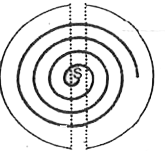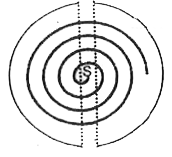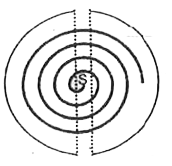To know the surface of matter on smallest scale we allow an energetic charged particle to slam into a solid target or allow two energetic charged particle to collide head on. We use cyclotrons to give very high kinetic energy to the charged particles, we arrange for the proton to circulate in a magnetic field and give it a modest electrical kick once per revolution. Two hollow D shaped objects, called does are part of an electrical oscillator that alternates the electric potential difference across the gap between the does back ad forth. the does are immersed in a magnetic field whose direction is out of the plane of page and that is set up by a large electromagnet, suppose a proton injected by a source S at the centre of the cyclotron, initially moves towards a negatively charged de. It will accelerate toward this doe and enter it. Once inside, it is shielded from electric fields by the copper walls of the dee: that is the electric field does not enter the dee. The magnetic field however is not screened by the copper dee. So, the proton moves in a circular path whose radius, which depends on speed is given by r=mvqB
The key to the operation of cyclotron is that the frequency f at which the proton circulates in the field and thaat does not depend on its speed must be equal to the fixed frequency Foce of the electrical oscillator. The resonance condition is given by
qB=2πmFoce

Suppose a cyclotron is operated at an oscillator frequency of 24 MHz and has a dee of radius 26.5 cm. Then what is the magnitude of the magnetic field needed for deuterons to be accelerated in the cyclotrons?
1.57 T
3.14 T
4.71 T
none of these
The correct Answer is:B
Topper's Solved these Questions
- MAGNETICBook:FIITJEEChapter:MAGNETICExercise:Comprehension -3
Explore 3 Videos
- MAGNETICBook:FIITJEEChapter:MAGNETICExercise:Comprehension -4
Explore 2 Videos
- MAGNETICBook:FIITJEEChapter:MAGNETICExercise:Comprehension -1
Explore 3 Videos
- LAWS OF MOTIONBook:FIITJEEChapter:LAWS OF MOTIONExercise:COMPREHENSION-III
Explore 2 Videos
- MAGNETISMBook:FIITJEEChapter:MAGNETISMExercise:Example
Explore 12 Videos
Similar Questions
Revision |When the charged particle is moving at an angle to the field |Motion of a charged particle in combined electric and magnetic field
View SolutionPositively charged particles are projected into a magnetic field. If the direction of the magnetic field is along the direction of motion of the charged particles, the particles get
View Solution
Knowledge Check
To know the surface of matter on smallest scale we allow an energetic charged particle to slam into a solid target or allow two energetic charged particle to collide head on. We use cyclotrons to give very high kinetic energy to the charged particles, we arrange for the proton to circulate in a magnetic field and give it a modest electrical kick once per revolution. Two hollow D shaped objects, called does are part of an electrical oscillator that alternates the electric potential difference across the gap between the does back ad forth. the does are immersed in a magnetic field whose direction is out of the plane of page and that is set up by a large electromagnet, suppose a proton injected by a source S at the centre of the cyclotron, initially moves towards a negatively charged de. It will accelerate toward this doe and enter it. Once inside, it is shielded from electric fields by the copper walls of the dee: that is the electric field does not enter the dee. The magnetic field however is not screened by the copper dee. So, the proton moves in a circular path whose radius, which depends on speed is given by r=mvqB
The key to the operation of cyclotron is that the frequency f at which the proton circulates in the field and thaat does not depend on its speed must be equal to the fixed frequency Foce of the electrical oscillator. The resonance condition is given by
qB=2πmFoce

What is the resulting kinetic energy of deuterons?A3.99×10−12JB2.7×10−12JC1012 eVDnone of theseTo know the surface of matter on smallest scale we allow an energetic charged particle to slam into a solid target or allow two energetic charged particle to collide head on. We use cyclotrons to give very high kinetic energy to the charged particles, we arrange for the proton to circulate in a magnetic field and give it a modest electrical kick once per revolution. Two hollow D shaped objects, called does are part of an electrical oscillator that alternates the electric potential difference across the gap between the does back ad forth. the does are immersed in a magnetic field whose direction is out of the plane of page and that is set up by a large electromagnet, suppose a proton injected by a source S at the centre of the cyclotron, initially moves towards a negatively charged de. It will accelerate toward this doe and enter it. Once inside, it is shielded from electric fields by the copper walls of the dee: that is the electric field does not enter the dee. The magnetic field however is not screened by the copper dee. So, the proton moves in a circular path whose radius, which depends on speed is given by r=mvqB
The key to the operation of cyclotron is that the frequency f at which the proton circulates in the field and thaat does not depend on its speed must be equal to the fixed frequency Foce of the electrical oscillator. The resonance condition is given by
qB=2πmFoce

If a proton circulates 200 times in a magnetic field of 1.5 T and receives an energy boost of 100 keV every time it completes an orbit it will end up with a kinetic energy ofA100 KeVB20 MeVC40 MeVD20 MeVA cyclotron is used to accelerate charged particles. Then the time period under the influence of 1T magnetic field of a proton :-
A20πnsB40πnsC10πnsD5πns
The motion of a charged particle can be used to distinguish between a magnetic field and electric field in a certain region by firing the charge
View SolutionA charged particle is projected at a very high speed perpendicular to a uniform magnetic field . The particle will
View SolutionVan de Graff generator is used to produce high energetic charged particles of energy of about
View SolutionPositively charged particles are projected into a magnetic field. If the direction of the magnetic field is along the direction of motion of the charged particles, the particles get
View SolutionA charged particle of charge q and mass m enters perpendiculalry in a magnetic field B. Kinetic energy of particle E, then frequency of rotation is
View Solution

